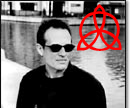

The Yamaha GX1 synthesizer is Led Zeppelin's most visually memorable keyboard. Originally, Yamaha developed the GX1 as a research model, and very few were sold. It is likely that only a dozen or so were made! A massive analog synthesizer, the GX1 is quite impressive. It was beautifully designed, with strong chrome legs supporting a white console. The main unit housed three keyboards -- two with standard size keys, and one with smaller keys. On the front panel, there were a variety of switches and buttons to program, store, and recall sounds. Beneath are a set of bass pedals similar to any home organ.
The GX-1 contains several very powerful polyphonic analog synthesizers, and it incorporates features for home organists and the professional rock/pop musician. Beside the great sonic possibilities of the synthesizer, the keyboards allowed levels of touch control never before seen. The top keyboard was small, with only half-sized keys. However, it had incredible expression with touch control. Selected parameters could be affected by velocity, aftertouch pressure, and key motion. The second large keyboard also had horizontal position control, meaning that to move a key side-to-side could produce vibrato and other such effects.
The GX-1 was an early design that would eventually evolve into the more commercial Yamaha CS80 synthesizer. As powerful as the GX1 was, it was still very expensive, so few musicians were able to afford it. Stevie Wonder made use of it early on and called it "The Dream Machine." During his Songs in the Key of Life album, he demonstrates it especially well on the tracks "Village Ghetto Land" and "Pastime Paradise," where he creates an animated string section. Keith Emerson also used the GX1, initially on ELP's Works Vol. 1 album, on "Pirates" and "Fanfare for the Common Man." It is also featured on their 1979 Live album on the opening track, "Peter Gunn."
John Paul Jones bought his GX1 around the time of the In Through the Out Door sessions in late 1978. The album was recorded in Stockholm, Sweden at the studio owned by ABBA. Benny Andersson, ABBA's keyboardist, may have influenced this purchase, since he was one of the few GX1 owners at the time. Jones used it on "Carouselambra," where he plays strong polyphonic synth sounds that create the main element in the song. The GX1 is the featured synthesizer throughout In Through the Out Door -- it can be heard on "In The Evening," "Carouselambra," "All My Love," and "I'm Gonna Crawl." In particular, Jones' string arrangement on "All My Love" is very realistic and the "baroque horn" solo demonstrates the expressive vibrato capacity.
On the final Led Zeppelin tours, John Paul Jones used the GX1 as his main keyboard. He would perform organ, clavinet, bass, and synthesizer parts with it. Although he called it "a joy" to replace the troublesome Mellotron, he later sold the GX1 to Keith Emerson as a spare. At the time, he claimed that many other keyboards could replicate its sound, and it nearly required "a full-time engineer to keep it going."
|
Yamaha GX-1
|
�